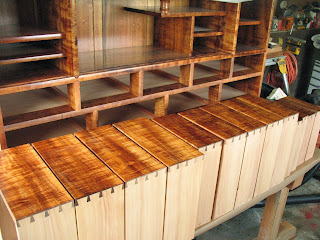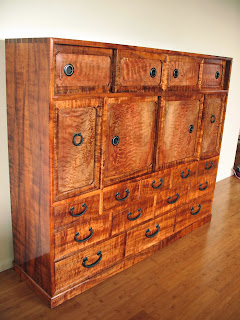The piece actually won Best of Show at the Harbor Gallery Annual Wood Show in Kawaihea, Hawaii. Many thanks to all that attended the show and voted for my piece. The work sold just after the show came down. The gallery listing is here. Here is a press release for the show from the West Hawaii Today. Anyone interested in current work please contact me via email.
So that's the good news from back in March. Yeah , way behind on the blog. So without further ado let's see that last bit of the chadansu build. Then I will take you along to see some other projects that went out this year and give you a tour of the wood I have been acquiring for up coming projects that will be introduced in future posts.
The last post of the chadansu build we looked at the carcass construction and interiors, back panel and tools I made to fashion some of the the details for the piece.
Let's see a few more images.......
These are the doors in their initial stages of construction without panels, grooves and interior bead detail. They are joined with thru tenons in the mitered corners.
I used the beading plane I introduced in the last post to fashion the inside bead detail.
The corners are shaped in with various chisels and carvers.
A final bit of detailing I save until the door is glued together.
Here are my panel parts. Some of that crazy Sugi from Mountain View. Elevation about 2500 feet.
This sugi is really challenging to hand plane. It's soft, like hand planing soft cheese. Even with a low angle plane I made just for planing this sugi, there were still areas that needed to get the fuzz knocked off.
I overlay the frames on the panel material to find a good fit with the grain.
The panels really glow with a couple coats super blonde shellac. There is no finish other than Urushi that compares to the deep warmth and luster of shellac. Hand planed surfaces with a rubbed shellac finish display exceptional depth.
The difference between a planed surface and a sanded surface is that the planed surface, already smooth with high sheen shows exceptional depth and will need less of a top coat film than a sanded surface that will benefits from the added chatoyancy created by a thicker top coat film. The thinner surface treatment has always seemed more refined to me. Although there are places and times to put on a bit more to really show some amazing wood off.
The panels are pre-finished prior to assembly, otherwise unfinished edges will show when the panels shrink over time.
Assembled here.
This shows the corners chamfered, tenons planed flush,fitted to the cabinet and ready for finishing.
So that was the process for all eight doors, 6 sliding and two flanking drop fit doors called kendon-buta.
The cabinet also featured 17 drawers, yes that's right, 17!!
They are all hand cut. They are made from Portuguese Cypress and Koa for the fronts. The cypress is nice to work with, it polished with planes nicely.
Over time I have developed the drawer I build now, I vary the thickness of parts depending on size of drawer or it's use but the over all form and detailing has started to be a constant.
.
The drawer fronts are half-blind dovetails. Standard stuff for a quality drawer.
Here is my drawer bottom I enjoy making.
It's clean, strong and easy to finish.
All the edges are detailed with a chamfer and surfaces are hand planed and left unfinished.
The bottoms are made from Port Orford Cedar, took on a really nice sheen as well. The spicy cedar scent it exudes last for decades, maybe longer.

After the drawers are glued up they get detailed and finish planed.
Then fitted to the cabinet for smooth action.
Here a close up showing final detailing .
How about some finish?
I really love this Curly Koa from Palani Ranch. It has a deep rich color and a lively figure. Still enough left for about three projects......
O.k. so that's my Matsukaze Drawer. I use a few species for the drawer boxes now.
Aside from this Portuguese Cypress I have been using a Tropical Ash, very similar to New England Black Ash polishes very nice. Silver oak which has lace figure when cut on the quarter and makes a stunning
drawer box. Like the one below from a recent work.
And of course Port Orford Cedar.
I will show you some amazing POC from Bob Sproul of East Fork Lumber Co. in an upcoming post. East Fork Lumber Co. is one of only a few mills that saw POC and is probably the only one that entertains custom orders. He stocks very rare and large old growth logs. Much of which is exported to Japan for high end residential construction and traditional timber work. I am currently stocking quarter sawn POC material up to 18" wide from old growth salvaged logs. 30~40+ rings per inch!! Thank-you Bob and Anne! I feel like the coolest kid on the block.
Look for tansu this winter featuring some of this amazingly rare old growth wood.
O.k., nuff gloating, back to the tansu.
This is the base I make for tansu that need an applied base. The frame is made with thick material and triple tenoned on each corner. It has two stretchers dovetailed in for reinforcement.
Here it is being fitted to the cabinet.
I like it very snug when it is first built. It's squeezed on.
The finishing came about in different sessions throughout the project.
Interior parts are prefinished,
Door panels before doors are assembled. The back panel in two different sessions,first the panels and then the frame after it is assembled.
The finishing accounts for about 25% of the project.
I really enjoy making cabinets with all the differing parts. Sliding doors and drawers, lift out doors and removable boxes. It makes the work very interactive.
Many of my current pieces also have secret boxes, hesokuribako.
Here is a nice box for removing from the cabinet to view it's contents. It is shown here, after the exterior has been finished but the box has not been "parted" yet from it's lid. The top is a tasty piece of sugi and the box sides are a quilted figure koa from the same log as the cabinet. The recesses in the sides to ease removing the lid are carved in a pine bow motif.
The lid is parted with a hand saw .
This was the finished product....
The dovetail pattern used on the box is inspired from those on a very old nagahibachi.
The inside is left with a hand planed surface. The sugi has a very spicy scent.
There were a few drawers behind the other kendon buta....
O.k. this brings me to the hardware....
The hardware is all hand forged with black hot oil finish. The C shaped handles are called warabite reminiscent of the warabi a fiddle head or fern sprout.
The odd man out is a hirute that was intended for the box. Hiru is a leech form.
Here is a set-up for installing hardware.
The holes for the handles are burned in to create the rectilinear shape of the straps. This keeps the handles tight and from twisting.
I've made several tools for installing hardware. Some from recycled screw drivers
others from old files.
All 18 handles installed....
That wraps it up I think. The piece took around 450 hours to complete and weighed a ton, or about 250 lbs. , and well over 300 crated. Here are a few parting images.....
I kinda like it with out the doors in the center. It gives the chadansu an entirely different feel.
Whew! Marathon post!
Thanks again to everyone that voted for the Chasdansu at last winter's 2013 Wood Show at Harbor Gallery in Kawaihea, Hawaii. I currently only show work at the Harbor Gallery. Gunner and Elli are great people and have the best of what the artisans of Hawaii have to offer. The Wood Show is the largest selling show on this Island.
I still have material enough for a half size version of the Chadansu detailed in the past few posts. Please send a note if interested. Limited supply of the Sugi and the Palani Ranch log.
Thank-you for taking the time to view the pics of the chadansu build by
Correy Smith of Matsukaze Woodworking in Hilo, Hawaii.
Next up in the blog roll is the monster monkey pod table with splayed leg base.
Stay tuned.
M A S T U K A Z E W O O D W O R K I N G
s i m p l e d e v i c e s f o r i n s p i r e d l i v i n g
H I L O H A W A I I
find me on the web at
There is no tansu available other than what is currently under construction.
Pictures of current work and release dates available upon request.
Please contact me for information on available work coming out soon.
Correy@matsukazewoodworking.com













































No comments:
Post a Comment
Please include full name when making comment
Blog is mainly for sharing images with clients and news about Matsukaze Woodworking. Other comments about craft, woodworking etc... are welcome at my other blog spot. Thank-you!